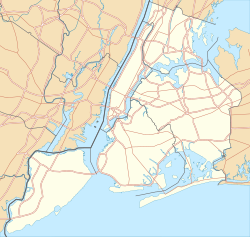Our website is made possible by displaying online advertisements to our visitors.
Please consider supporting us by disabling your ad blocker.
Fort Schuyler
| Fort Schuyler | |
|---|---|
| Part of Harbor Defenses of Eastern New York 1898–1934 | |
| Throgs Neck at East River and Long Island Sound, New York, New York | |
 Southern main gate | |
| Coordinates | 40°48′20″N 73°47′31″W / 40.80556°N 73.79194°W |
| Type | Garrison fort, training camp |
| Site information | |
| Owner |
|
| Controlled by |
|
| Open to the public | Yes |
Fort Schuyler | |
New York City Landmark No. 0124
| |
| Area | 17 acres (6.9 ha) |
| Built | 1833–1856 |
| Architect | Capt. I.L. Smith (probably John Lind Smith (died 1858) of the US Army Corps of Engineers)[2] |
| Architectural style | Third system of US fortifications |
| NRHP reference No. | 76001206[1] |
| NYCL No. | 0124 |
| Significant dates | |
| Added to NRHP | June 29, 1976 |
| Designated NYCL | April 19, 1966 |
| Condition | Intact, occupied |
| Site history | |
| Built by | United States Army Corps of Engineers |
| In use | 1861–present |
| Battles/wars | American Civil War World War I |


Fort Schuyler is a preserved 19th century fortification in the New York City borough of the Bronx. It houses a museum, the Stephen B. Luce Library, and the Marine Transportation Department and Administrative offices of the State University of New York Maritime College. It is considered one of the finest examples of early 19th century fortifications. The fort was named in honor of Major General Philip Schuyler of the Continental Army.[3]
- ^ "National Register Information System". National Register of Historic Places. National Park Service. March 13, 2009.
- ^ Heitman, Francis B. (1903). Historical Register and Dictionary of the United States Army, 1789-1903, Vol. 1. Washington, DC: Government Printing Office. p. 900.
- ^ Cite error: The named reference
FWiki1was invoked but never defined (see the help page).
Previous Page Next Page





